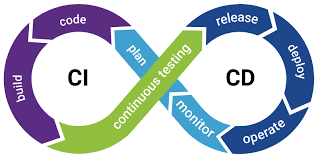App Store for Developers
The following information includes Akinon’s limitations, recommendations, and guidance regarding each step of the CI/CD pipeline for applications to be published on the App Store. Developments based on this guide, applications can easily integrate with Akinon’s infrastructure.

Code
The codebases of your applications are stored in repositories that are exclusively created for and accessible by you. Akinon prefers Git as the version control system. Please see the related articles titled Creating a Public Key and Creating an Application to learn more about how to access and use code repositories.
The backing services that might be required for your application (including Postgre, Redis, Mail, CDN, and ElasticSearch) will be provided by Akinon’s infrastructure. Developments to be made during the build phase in order to use these services will be given in the next section. Responsibility for other technologies to be used belongs to the developer.
Application needs to be developed EaC, i.e. “everything as a code.” For instance, the DML (Data Manipulation Language), DCL (Data Control Language), and DDL (Data Definition Language) actions to be run on the DB are expected to be automatically executed during the deployment of migrations, using a management tool such as Liquidbase.
Build
Within Akinon’s infrastructure, the phases for build, release, and deploy actions are clearly differentiated. The imported code which is transferred to your code repository, must be built without any problems in order to proceed to the next stages. In terms of managing dependency hierarchy and dependency isolation, Akinon recommends using a project build and dependency management tool. (NPM, Maven, Setuptools, etc.)
Certain additional builds are required to deploy to Akinon’s PaaS infrastructure. In light of these builds, necessary preparations will be made to ensure the code works in a containerized environment and a build output of the code will be stored. Please follow the directions for useful information on Building Versions.
Continuous Testing
Akinon expects your application’s unit tests to automatically run during the build phase. In case of a failure during unit testing, it carries critical significance for your application’s well-being to not get the build. Otherwise, unwanted errors will be encountered during production.
It’s important that your unit testing is not externally dependent so as not to prolong the build time or interrupt the build in case of inability to access the dependent resource.
Static code analysis will be run in your application during builds and/or at unspecified intervals both for security and code quality reasons. Akinon reserves the right to request reviews when necessary.
Release
The release phase is the combination of post-build code and configurations related to the environment where the code will be working. Akinon dynamically sends to containers the build information for required addons (akinon.json, etc.) during its builds for Akinon PaaS, and recommends running application builds with environment variables. Thus, the build and release phases follow one another. Using the Tag information provided on the page Building Versions, your application’s release will be created automatically.
Deploy
The outputs that are ready to work in the containerized environment created during the build and release phases are deployed by following the steps on the Deploying an Application page. If it’s a web application, it’s expected to use the 8008 port.
To automatically run your DB migrations during the deployment of your application, you must take the necessary precautions outlined in the Code section.
Operate
Applications will run in a containerized environment and require constant maintenance for healthy performance. Thus, a HealthCheck endpoint needs to be created to constantly check each instance of your application. To do this, please follow the HealthCheck directions.
Your applications need to work multi-instance for high availability while avoiding consistency problems. Additionally, it’s important to design your applications in an architecture that works in a stateless way because, in terms of the infrastructure, no guarantee is ensured for sticky sessions.
Rest services are used for communication between services. Akinon recommends service design to comply with REST API design principles and be at Richardson Maturity Model level 2 or higher. Service versioning (e.g. /v1/products) and implementing a deprecated service policy will make the processing of your project more convenient. Akinon recommends creating service points that comply with _open-api 2.0> standards and in the `/open-api`_ endpoints.
The timeout duration for communication between services is 30 seconds. Applications and services need to be developed with these limitations in mind. Once SSL termination is run at load balancers, requests will be sent to your application. Please refer to this Deploying the Application to the Project guide to find the URL information under application details to access the application.
If your applications use excessive resources (cpu, memory, disk, etc.) when working, they may automatically be placed in recycle. If the application requires a high level of resources, Akinon expects to be informed in advance. Additionally, Akinon recommends taking protective measures regarding the transactional integrity of the application by designing it to process SIGTERM signals and to shut down in the minimum amount of time (1 minute at most).
Monitoring
Applications should add the X-Trace-Id header received for tracing to other requests to be made. If it’s not present in the incoming request or it’s sending the initial request, Akinon recommends adding a value in UUID standards to this header before proceeding.
Akinon recommends writing application logs to the console. Access to these logs (in real time or at certain intervals) is provided via the user panel and software (metric/log addon).
Plan
If the application has an interface, it needs to comply with the sample interfaces uploaded to the App Store. To check this and additional controls, an active user account for Akinon must be provided during the review phase.
Result
We’ve provided some directions with regard to both your application’s compliance with the Twelve Factor App methodology and its compatibility and management with Akinon’s infrastructure.